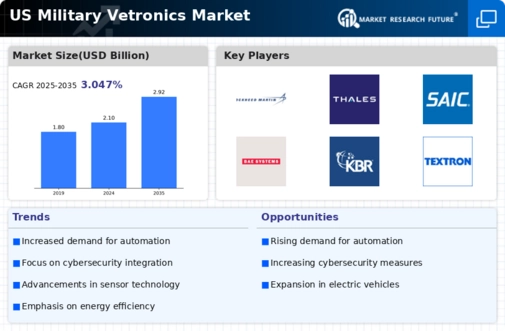Increased Defense Budgets
The military vetronics market is significantly influenced by the increase in defense budgets across the United States. In recent years, the U.S. government has allocated substantial funds to enhance military capabilities, with a focus on modernization and readiness. For example, the defense budget for FY 2025 is projected to exceed $800 billion, with a considerable portion earmarked for advanced technologies and systems. This financial commitment is likely to bolster the military vetronics market, as defense contractors and manufacturers respond to the demand for state-of-the-art equipment. The infusion of capital into research and development initiatives is expected to yield innovative solutions that enhance the performance and reliability of military vehicles, thereby driving market growth.
Focus on Cybersecurity Measures
As military operations increasingly rely on digital systems, the military vetronics market is witnessing a heightened focus on cybersecurity measures. The integration of advanced electronics in military vehicles exposes them to potential cyber threats, necessitating robust security protocols. The U.S. Department of Defense has recognized this challenge and is investing in cybersecurity solutions to protect critical systems. This trend is likely to drive the demand for secure vetronics systems, as military forces prioritize the integrity and safety of their operations. The emphasis on cybersecurity is expected to shape the development of new technologies within the military vetronics market, ensuring that systems are resilient against evolving threats.
Growing Emphasis on Modular Systems
The military vetronics market is increasingly leaning towards modular systems that offer flexibility and adaptability. Modular designs allow for the rapid integration of new technologies and upgrades, which is essential in a fast-evolving battlefield environment. This approach not only reduces costs associated with retrofitting but also enhances the longevity of military vehicles. The U.S. military is actively pursuing modular solutions to streamline logistics and maintenance, which could lead to a more efficient operational framework. As a result, the demand for modular vetronics systems is likely to rise, reflecting a strategic shift towards more versatile and future-proof military capabilities.
Technological Advancements in Vetronics
The military vetronics market is experiencing a surge in demand due to rapid technological advancements. Innovations in electronics, software, and hardware are enhancing the capabilities of military vehicles. For instance, the integration of artificial intelligence (AI) and machine learning is enabling real-time data analysis and decision-making. This trend is reflected in the projected growth of the market, which is expected to reach approximately $10 billion by 2027. Furthermore, the adoption of advanced sensors and communication systems is improving situational awareness and operational efficiency. As military forces seek to modernize their fleets, the emphasis on cutting-edge technology is likely to drive investments in the military vetronics market, ensuring that systems remain competitive and effective in various operational environments.
Enhanced Training and Simulation Technologies
The military vetronics market is benefiting from advancements in training and simulation technologies. As military operations become more complex, the need for effective training solutions is paramount. The integration of virtual reality (VR) and augmented reality (AR) in training programs is revolutionizing how personnel are prepared for real-world scenarios. The U.S. military is investing in these technologies to create immersive training environments that enhance skill acquisition and operational readiness. This trend is expected to drive the demand for sophisticated vetronics systems that support training initiatives, ultimately contributing to improved performance in actual missions.
















